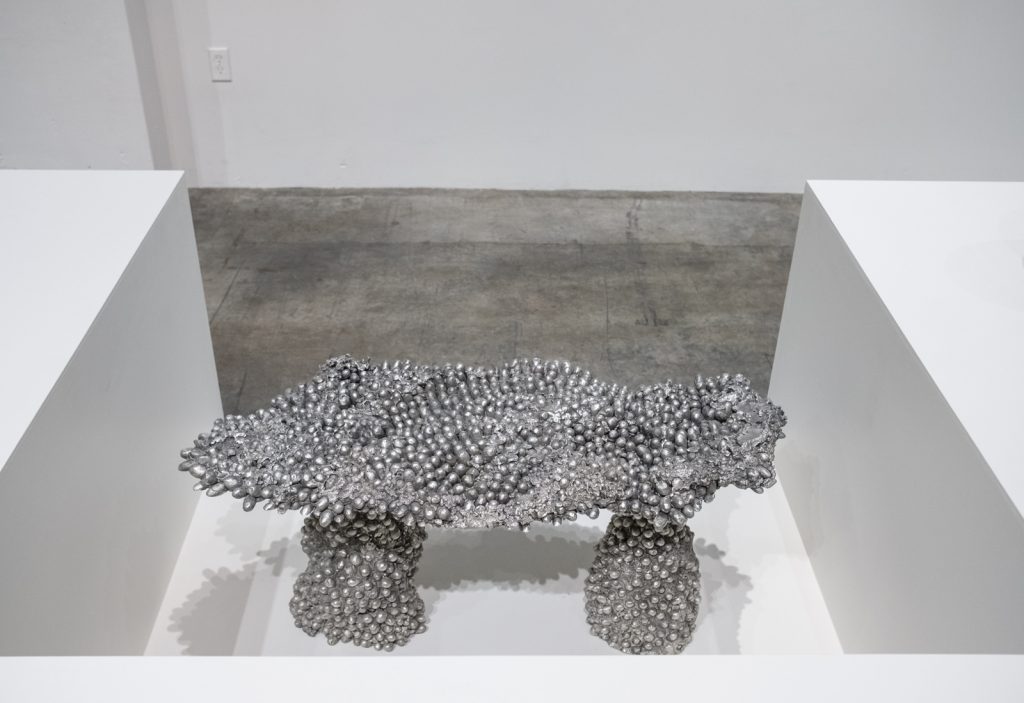Raw Design: Material matter(s)
The Museum of Craft and Design explores how and why material research is booming in the 21st century in their current exhibition ‘Raw Design’
Shiny bulbous columns and spheres are presented alongside jagged mineral-like structures and rocky reconstructions. It seems to be a futuristic stone-age, where the uncannily natural sit alongside the synthetic in an exploration of unapologetic materiality.
The exhibition Raw Design, currently on show at San Francisco’s Museum of Craft and Design presents a series of objects and various man-made material specimens. It examines the increasing number of designers and artists who treat material and its production as the main element of their work. Their practice is defined by a DIY attitude and low-tech tools, allowing them to become experimentalists and material inventors. Curator, Glenn Adamson states that the exhibition “demonstrates that palpable physicality is by no means obsolete as a creative force”.
The exhibition takes place at a time of expanding interest in material exploration that has been quietly growing since Italian architect, artist and designer, Gaetano Pesce, pioneered this way of working in the 1960’s. Globally, schools are creating Material Libraries that offer students resources to further push their assumptions about materials. Simultaneously, universities are offering courses that encourage experimentation with matter and do not adhere to rigid notions of design. Adamson cites the Bay Area’s California College of the Arts as just one example of this. Furthermore, the publication Radical Matter by future forecasters Caroline Till and Kate Franklin released in February this year, is a testament to the keen interest in this area. The book is a compendium of creatives working with materials in new ways to redefine production and consumption cycles.
But why this booming interest in materiality and production? What does this way of working offer? The richness of the pieces on display at Raw Design offer layers of answers to these questions.
At its most simple, the objects produced through this way of working are beautiful and engaging. Max Lamb’s terrazzo aggregate Marmoreal, developed in conjunction with the material development incubator Dzek brings together waste fragments of different coloured marbles into a stunning new “stone” made from 95% marble and 5% binding resin. It is not only a new material but also an immersive piece of graphic design. Dana Barnes’s wool-impregnated concrete blocks are intriguing and visceral in their combination of opposing materials.
Furthermore, the tantalisingly tactile and foreign forms sit far from the slick world of mass-produced goods that define 21st-century life. This refreshing contrast invites consideration of how these things are made. It examines systems of production on a small and experimental scale and, in turn, questions the domination of mass-production chains. Adamson states that “acts of making can be reframed as ethical research methods. By literally taking matter into their own hands, designers not only confront the preconditions of their own productions, but also explore how the world around us is generally made.”
A key example of this is New York-based artist, Zoë Sheehan Saldaña’s Milk Paint which coats the walls of the galleries. The paint is a DIY recipe that the artist has developed and circulated for others to use. It interrogates the need for the chemical-heavy paint that is commonly available. It also sheds lights on political histories surrounding labour and unrest.
At a broader level, the exhibition examines the ever-intensifying level of digital objects and screen-based interactions as the cause of this renewed interest in the physical. The works can be seen as a form of protest against or an unconscious reaction to high levels of screen time. Although our current relationship to technology is far more complex than digital vs. physical, the exhibition gives an alternative possibility for design that is not technologically-driven. It questions the status of digital objects as the sole future of design.
Finally, in a world striving for new ideas and solutions, the works demonstrate the fruitfulness of collaborations across disciplines, especially between the creative arts and the sciences. Adamson describes the most dramatic example of this as the use of lava by GT2P (Great Things To People), a Chilean collective. “They have consulted with scientists, and have successfully developed techniques of grinding and re-melting the stone so that it can be used as a casting material or a ceramic glaze.”
Another example is Marlène Huissoud’s objects which are built from “cocoons spun by silkworms [and] varnished in a resin secreted by honeybees. They are in a sense are grown rather than made.” This biological approach blurs the boundaries between design, science, and nature.
Raw Design presents “contemporary design in its most fundamental condition – as material intervention”, giving a clear insight into what this can offer and why it is important. It shows designers, not as passive producers, but as active explorers of our complex world.
Raw Design is on show until October 28












